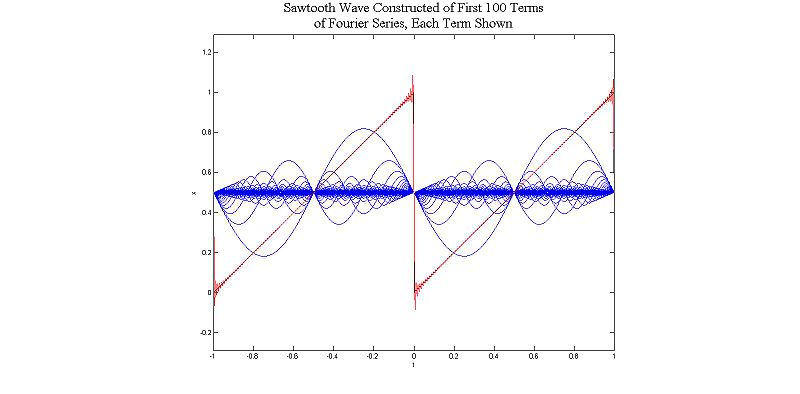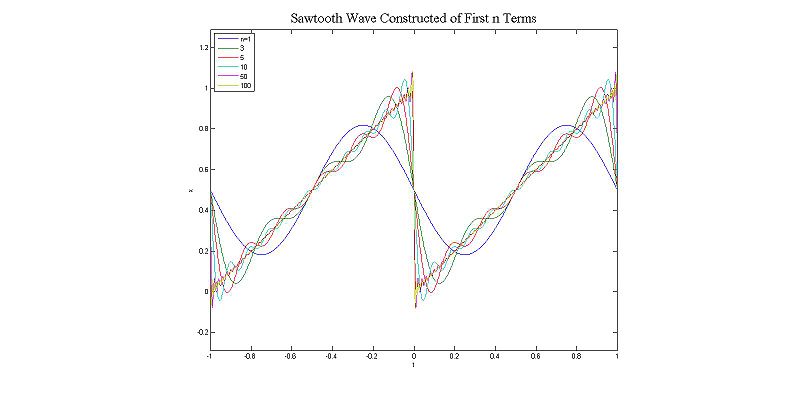|
|
| Line 17: |
Line 17: |
|
<br /> |
|
<br /> |
|
|
|
|
|
<center><math> x(t)=\sum^\infty_{n=0} \left[a_n\cos\frac{2\pi nt}{T}+b_n\sin\frac{2\pi nt}{T}\right]</math></center> |
|
<center><math> x(t)=\frac{a_0}{2}+\sum^\infty_{n=1} \left[a_n\cos\frac{2\pi nt}{T}+b_n\sin\frac{2\pi nt}{T}\right]</math></center> |
|
|
|
|
|
<br /> |
|
<br /> |
| Line 35: |
Line 35: |
|
<br /> |
|
<br /> |
|
|
|
|
|
For the sawtooth function given, we note that <math>T=1</math>, and an obvious choice for <math>c</math> is 0 since this allows us to reduce the equation to <math>x(t)=t</math>. It remains, then, only to find the expression for <math>a_n</math> and <math>b_n</math>. We proceed first to find <math>b_n</math>. For <math>b_n</math> we can ignore the case when <math>n=0</math> because <math>\sin\,\! 0=0</math>. Hence, we proceed for <math>n=1,2,3\dots</math>: |
|
For the sawtooth function given, we note that <math>T=1</math>, and an obvious choice for <math>c</math> is 0 since this allows us to reduce the equation to <math>x(t)=t</math>. It remains, then, only to find the expression for <math>a_n</math> and <math>b_n</math>. We proceed first to find <math>b_n</math>. |
|
|
|
|
|
<br /> |
|
<br /> |
| Line 81: |
Line 81: |
|
</center> |
|
</center> |
|
|
|
|
|
Now, for <math>a_n</math> we must consider the case when <math>n=0</math>. |
|
Now, for <math>a_n</math> we must consider the case when <math>n=0</math> separately. |
|
|
|
|
|
<br /> |
|
<br /> |
| Line 87: |
Line 87: |
|
<center> |
|
<center> |
|
|
|
|
|
<math>a_0=\int_0^1t\ dt=\frac{t^2}{2}\bigg|_0^1=\frac{1}{2}</math> |
|
<math>a_0=\frac{2}{1}\int_0^1t\ dt=t^2\bigg|_0^1=1</math> |
|
|
|
|
|
</center> |
|
</center> |
Revision as of 13:35, 12 January 2010
Problem Statement
Find the Fourier Tranform of the sawtooth wave given by the equation

Solution
As shown in class, the general equation for the Fourier Transform for a periodic function with period  is given by
is given by
![{\displaystyle x(t)={\frac {a_{0}}{2}}+\sum _{n=1}^{\infty }\left[a_{n}\cos {\frac {2\pi nt}{T}}+b_{n}\sin {\frac {2\pi nt}{T}}\right]}](https://wikimedia.org/api/rest_v1/media/math/render/svg/04bac4a13740a6ddbef45506c7c22a4db2c9aad8)
where

For the sawtooth function given, we note that  , and an obvious choice for
, and an obvious choice for  is 0 since this allows us to reduce the equation to
is 0 since this allows us to reduce the equation to  . It remains, then, only to find the expression for
. It remains, then, only to find the expression for  and
and  . We proceed first to find
. We proceed first to find  .
.

which is solved easiest with integration by parts, letting


so
![{\displaystyle b_{n}=2\left[t\left(-{\frac {1}{2\pi n}}\right)\cos 2\pi nt{\bigg |}_{0}^{1}+{\frac {1}{2\pi n}}\int _{0}^{1}\cos 2\pi nt\ dt\right]}](https://wikimedia.org/api/rest_v1/media/math/render/svg/233867d3cc9632255b92139ff09a3604bb5b6683)
![{\displaystyle =2\left[\left(-{\frac {1}{2\pi n}}\cos 2\pi n-0\right)+\left({\frac {1}{2\pi n}}\right)^{2}\sin 2\pi nt{\bigg |}_{0}^{1}\right]}](https://wikimedia.org/api/rest_v1/media/math/render/svg/0e0c18b2e8b52515773779ca17a4f2b714c90b97)
![{\displaystyle =2\left[-{\frac {1}{2\pi n}}(1)+0\right]}](https://wikimedia.org/api/rest_v1/media/math/render/svg/68609662576139dfd8a75c771f5ef7397ee879e2)

Now, for  we must consider the case when
we must consider the case when  separately.
separately.

For  , we have
, we have

which again is best solved using integration by parts, this time with


so
![{\displaystyle a_{n}=2\left[t\left({\frac {1}{2\pi n}}\right)\sin 2\pi nt{\bigg |}_{0}^{1}-\int _{0}^{1}{\frac {1}{2\pi n}}\sin 2\pi nt\ dt\right]}](https://wikimedia.org/api/rest_v1/media/math/render/svg/689bb819034a37bed8e33ca2fd67db4be2138c5c)
![{\displaystyle 2\left[\left({\frac {1}{2\pi n}}\sin 2\pi n-0\right)-\left[-\left({\frac {1}{2\pi n}}\right)^{2}\cos 2\pi nt\right]_{0}^{1}\right]}](https://wikimedia.org/api/rest_v1/media/math/render/svg/3ac13771b1bb0941e0396a9d04891df61e01e0f2)
![{\displaystyle =2\left[0+\left({\frac {1}{2\pi n}}\right)^{2}\left(\cos 2\pi n-\cos 0\right)\right]}](https://wikimedia.org/api/rest_v1/media/math/render/svg/66cd9e52e98d0341fa22b5aa9410305d3a91c5a9)

Therefore, the Fourier Transform representation of the sawtooth wave given is:

The figures below graph the first few iterations of this solution. The first graph shows the solution truncated after the first 100 terms of the infinite sum, as well as each of the contributing sine waves with offset. The second figure shows the function truncated after 1, 3, 5, 10, 50, and 100 terms.
Author
John Hawkins
Read By
Reviewed By


![{\displaystyle x(t)={\frac {a_{0}}{2}}+\sum _{n=1}^{\infty }\left[a_{n}\cos {\frac {2\pi nt}{T}}+b_{n}\sin {\frac {2\pi nt}{T}}\right]}](https://wikimedia.org/api/rest_v1/media/math/render/svg/04bac4a13740a6ddbef45506c7c22a4db2c9aad8)









![{\displaystyle b_{n}=2\left[t\left(-{\frac {1}{2\pi n}}\right)\cos 2\pi nt{\bigg |}_{0}^{1}+{\frac {1}{2\pi n}}\int _{0}^{1}\cos 2\pi nt\ dt\right]}](https://wikimedia.org/api/rest_v1/media/math/render/svg/233867d3cc9632255b92139ff09a3604bb5b6683)
![{\displaystyle =2\left[\left(-{\frac {1}{2\pi n}}\cos 2\pi n-0\right)+\left({\frac {1}{2\pi n}}\right)^{2}\sin 2\pi nt{\bigg |}_{0}^{1}\right]}](https://wikimedia.org/api/rest_v1/media/math/render/svg/0e0c18b2e8b52515773779ca17a4f2b714c90b97)
![{\displaystyle =2\left[-{\frac {1}{2\pi n}}(1)+0\right]}](https://wikimedia.org/api/rest_v1/media/math/render/svg/68609662576139dfd8a75c771f5ef7397ee879e2)






![{\displaystyle a_{n}=2\left[t\left({\frac {1}{2\pi n}}\right)\sin 2\pi nt{\bigg |}_{0}^{1}-\int _{0}^{1}{\frac {1}{2\pi n}}\sin 2\pi nt\ dt\right]}](https://wikimedia.org/api/rest_v1/media/math/render/svg/689bb819034a37bed8e33ca2fd67db4be2138c5c)
![{\displaystyle 2\left[\left({\frac {1}{2\pi n}}\sin 2\pi n-0\right)-\left[-\left({\frac {1}{2\pi n}}\right)^{2}\cos 2\pi nt\right]_{0}^{1}\right]}](https://wikimedia.org/api/rest_v1/media/math/render/svg/3ac13771b1bb0941e0396a9d04891df61e01e0f2)
![{\displaystyle =2\left[0+\left({\frac {1}{2\pi n}}\right)^{2}\left(\cos 2\pi n-\cos 0\right)\right]}](https://wikimedia.org/api/rest_v1/media/math/render/svg/66cd9e52e98d0341fa22b5aa9410305d3a91c5a9)



